Garet Bleir has spent the last 100 days living out of a tent beside the Carrizo/Comecrudo Nation and allies in the Esto’k Gna’s villages near the U.S.-Mexico border. He is there investigating the humanitarian and environmental devastation caused by the border wall sweeping through South Texas. This story was made possible with a grant from the Swiss human rights organization Incomindios and is republished with permission from Intercontinental Cry. It is part one of an ongoing series.
The Carrizo/Comecrudo tribe of Texas, or Esto’k Gna in their own language, are indigenous to both sides of the Rio Grande river and throughout present-day South Texas, northern Mexico, eastern New Mexico; lands known as Somi Se’k. Today, the 1,600-member nation, based south of San Antonio, is fighting for a future that resembles their past: one devoid of borders. The original caretakers of South Texas, but lacking state or federal recognition as a nation, the Esto’k Gna people are fighting for their ancestors buried along the banks of the Rio Grande and in the Eli Jackson and Jackson Ranch Chapel cemeteries to spare them from desecration or exhumation by border wall construction.
The Eli Jackson Cemetery is exemplary of the complex history and multiple levels of oppression and community division that have ravaged the so-called United States of America. Next to the ancestors of the Esto’k Gna lies a Texas Ranger, a member of a group created for the purpose of eradicating Indigenous peoples in Texas to make way for settler-colonial communities; and next to freedmen lie soldiers of the Confederacy, who fought for the continuation of slavery.

Wreath hung by the Esto’k Gna at the Eli Jackson Cemetery in honor of the veterans on Memorial Day.Photo: Garet Bleir
Lying right next to the Jackson Ranch Methodist Chapel and Cemetery, the Eli Jackson Cemetery is the resting place to over 150 people. This includes relatives and ancestors of the Esto’k Gna; freedmen from the ranches existence as an outpost of the Underground Railroad; World War I, World War II, and Korean war veterans; and family members of those who still come to visit the cemetery today. This diverse group of ancestors lying in these grounds has generated a broad coalition of descendants and allied resistors fighting to save their ancestors’ remains, history, and final resting place.

Eli Jackson Cemetery. Photo: Garet Bleir
The Eli Jackson cemetery, a quarter-acre plot of weathered headstones and crosses, rests two miles north of the Rio Grande, the current delineation of the U.S./Mexico border and a river held sacred by the Esto’k Gna. It also happens to rest just several yards south of the earthen levee that is the planned site of Trump’s border wall.
This means that the site is at risk of destruction and desecration as it lies within the border wall’s 150-foot-wide enforcement zone, including a roadway and surveillance towers. Through funding secured by Congress in 2018, President Trump was able to put $1.6 billion towards funding this section of the wall as well as other lands set to be impacted by this construction: The National Butterfly Center, La Lomita Chapel, and Santa Ana Wildlife Refuge in Hidalgo County, and over 13,000 acres of critical wildlife refuge tracts in Cameron and Starr counties alone, just to name a few of the impacted areas, according to Laiken Jordahl of the Center for Biological Diversity.
When asked if U.S. Customs and Border Protection (CBP) and/or its contracted construction firms plan to build border structures through the property of the Eli Jackson Cemetery, CBP responded that, while the cemetery isn’t part of the recently awarded contract to general contracting and construction management company SLSCO, “the cemetery is adjacent to the levee within future planned levee wall and enforcement zone.” CBP added that “However, in sensitive areas such as this, CBP will employ mitigation strategies whenever possible to avoid or minimize the impact,” although it is unclear at this point what that might look like.
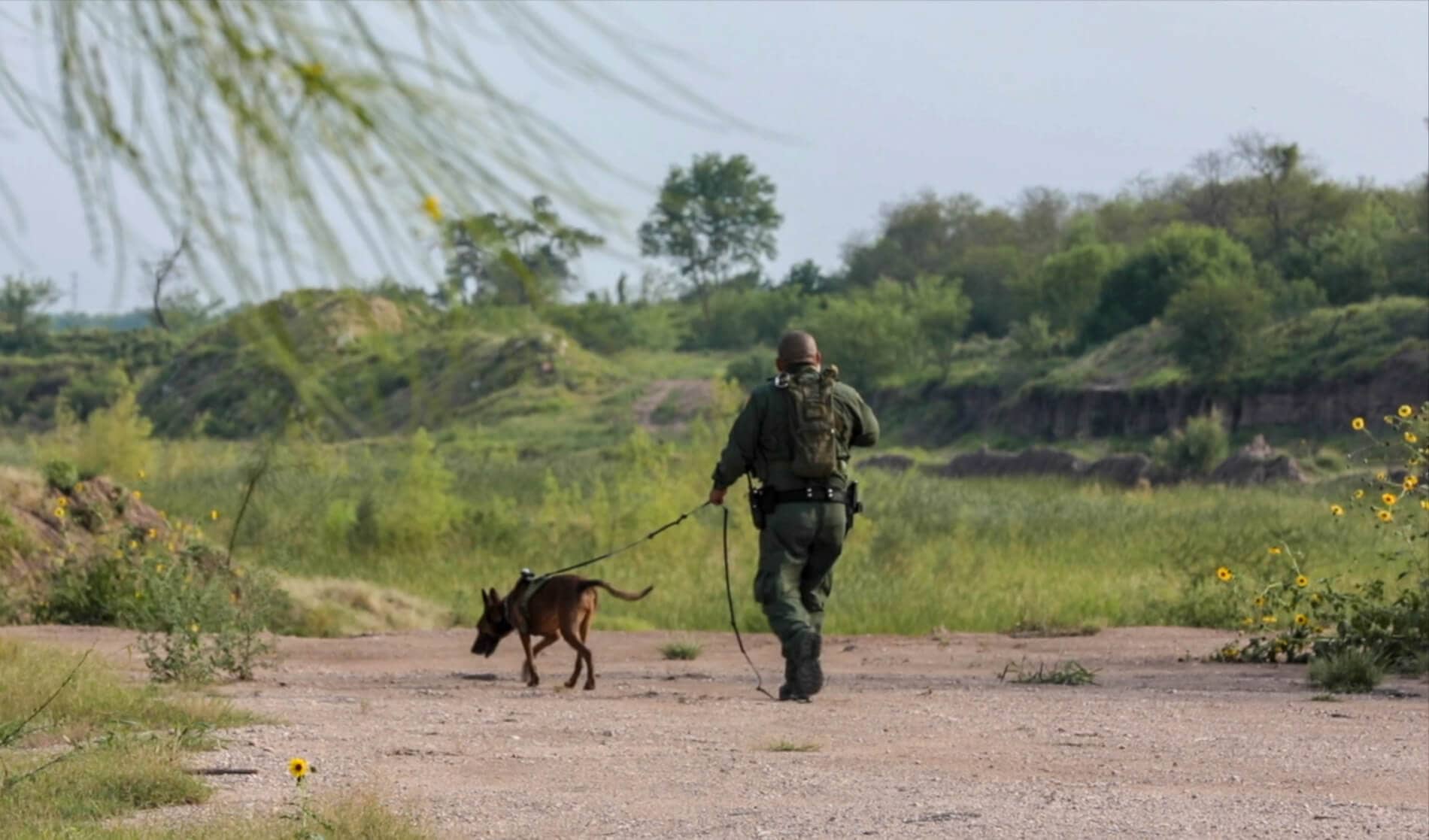
Border patrol searching fields outside of Yalui Village at the Eli Jackson Cemetery. Photo: Garet Bleir
The Esto’k Gna are worried that the construction of the U.S./Mexico border wall will unearth their ancestors remains as well as culturally significant artifacts not only along the Eli Jackson Cemetery in San Juan, Texas, but all along ancestral burial sites and villages along the Rio Grande.
This area, including the levee that the border wall will be placed on, is no stranger to the desecration of human remains and artifacts. “There is oral witnessing to the fact that they were digging the canal and the levee here years ago and they threw bones aside like they were nothing,” says Juan Mancias, chairman of the Carrizo/Comecrudo Nation. “I can’t tell you how many of our sacred sites have been looted over the last 150 years.”
Border Patrol agents who have retired or quit have brought back arrowheads and other items they have stolen from the areas over time, he adds. “They’re about to be digging up our bones,” says Mancias. “They’re going to loot it; They’re the criminals, they’re waiving the law to break the law.”

Juan Mancias, Chairman of the Carrizo/Comecrudo Nation. Photo: Garet Bleir
The Eli Jackson cemetery along with other burial grounds along the Rio Grande River would normally be protected under such acts as the Antiquities Act, the National Historic Preservation Act, the Archaeological Resources Protection Act, and the Native American Graves Protection and Repatriation Act – the latter of which requires federal agencies to return unearthed remains and artifacts of Indigenous peoples to their lineal descendants. However, former Secretary of Homeland Security Department Kirstjen Nielsen has evoked powers given under Section 102(c) of the Illegal Immigration Reform and Immigrant Responsibility Act of 1996 to waive all laws that interfere with the expeditious construction of barriers in the interest of national security, in order to wave NAGPRA and 28 other federal laws in order to construct the border wall, many of which are key environmental protections as well as safeguards for historic sites and human remains.
“If you don’t know what a broken treaty is, every one of you as a U.S. citizen is going through broken treaties right now. When they start waiving laws that apply to every one of you, every one of you as a citizen, every one of your children, they’re breaking treaties with you,” says Mancias. “They’ve waived the right to have clean water, the right to have clean air, the right to be able to hold these things sacred, to see the endangered ocelot, the great egret, and the blue herons. All of these things need to be looked at and say, ‘I have a right to see that, my children have a right to see that, my grandchildren have a right to see that.’”

Juan Mancias, Chairman of the Carrizo/Comecrudo Nation and Orlando Cruz of the Santa Ana Pueblo Nation singing on the banks of the Rio Grande, a river sacred to the Esto’k Gna. Photo: Garet Bleir; Photo Editing: Azul Perez Lañas.
Many members of the Carrizo/Comecrudo community fear that waiving these laws could lead to improper handling of the remains of their ancestors, given that there is no longer any federal requirement to return these remains and artifacts to their lineal descendants or even to notify them that they have been found.
This is a continuation of a history of desecration of Indigenous peoples’ remains, with 150,887 deceased Native American, Alaskan Native, and Native Hawaiian persons identified in the collections of federally funded museums, universities and federal agencies alone — the grand majority of which have yet to be repatriated to their proper Indigenous nation. It is also a continuation of the genocidal systems and policies of forced forgetting of Indigenous identity and culture.
When we asked what measures CBP is taking to ensure the safe and responsible handling of cultural artifacts or human remains that may be unearthed during the construction of border structures, they responded simply that “CBP conducts environmental and cultural surveys in order to identify and mitigate any potential impacts to sensitive areas.”
CLASH IN THE COURTS

March against the border wall at the National Butterfly Center in conjunction with the Carrizo Comecrudo Nation. Photo: Garet Bleir
Following the bipartisan House and Senate efforts to reject President Trump’s declaration of a national emergency at the U.S. southern border allowing for additional miles of border wall, Earthjustice filed a lawsuit in the U.S. District Court for the District of Columbia on behalf of the Carrizo/Comecrudo Nation of Texas, the Ramirez family, the Rio Grande International Study Center, Elsa Hull — a private landowner on the border — as well as local and national leaders representing affected communities along the border wall’s path.
The lawsuit rebukes President Trump’s emergency declaration, which is currently active due to the veto he enacted and the House and Senate’s inability to override that veto. The lawsuit claims that the emergency declaration is a “fabrication to seize emergency powers in an attempt to accomplish a long-standing campaign promise,” and “completely untethered to the facts on the ground.” It goes on to decry what it says is endangerment to private property, wetlands, wildlife habitats, and parks, in addition to gravesites and spiritual ancestral areas as it serves to “divide neighbors; alienate border communities, researchers, and nature lovers from the Rio Grande River; defile landscapes; and militarize communities.”
On May 24, a federal judge ruled that the President was not allowed to use Department of Defense funds to build certain sections of the border wall, but the recent ruling does not prevent the administration from securing funds sourced from elsewhere in order to continue building. “We don’t own the land on the border; the land on the border owns us,” says Mancias. “It is a part of us to live as our ancestors lived — the border wall would sever our connection to them. Our Nation is proud to join this lawsuit, and take a stand for our home.”

Juan Mancias, Chairman of the Carrizo/Comecrudo Nation alongside Carrizo/Comecrudo Nation member Eddie Garcia honoring the veterans of the Jackson Ranch Chapel and Eli Jackson cemeteries on Memorial Day. Photo: Garet Bleir
REBUILDING ANCESTRAL VILLAGES, RESISTING ANCESTORS’ DESECRATION
The Carrizo/Comecrudo Tribe of Texas along with other Native and non-Native allies have united on the grounds of the Eli Jackson cemetery. There they have created a village in direct opposition to and in the way of the proposed border wall construction, as they send up prayers for a resolution to this proposed destruction, and assure that sacred sites are not looted during construction.
“We are speaking out for our sacred sites,” says Mancias. “We as the original people of Texas have aboriginal inherent rights to this area. We have a duty to the ancestors that we finally have started to implement. Our direct action is that we’re here on the cemetery to protect it.”

Carrizo/Comecrudo Nation members marching from the Eli Jackson Cemetery to the Jackson Ranch Chapel Cemetery on Memorial Day. Left to Right: Christa Mancias, future Chairwoman of the Carrizo/Comecrudo Nation; Miguel Zapata; Amanda Gurkins. Photo: Garet Bleir
“This land here, we don’t own it. This land, it owns us. We are this land. Our ancestors are here and have been part of this land for over 10,000 years. They’re disrespecting your relatives and they’re disrespecting my ancestors and our ways of life when they do this,” he adds. “My spirituality lies in those tears, in that blood, and in that sweat that my people have given so that I can say I am Esto’k Gna, so that I can say Ayema Payase’l, Give Life to everything that is here.”
Chairman Juan Mancias, Carrizo/Comecrudo Nation
Mancias plans to join indigenous and non-indigenous allies to rebuild the Esto’k Gna’s ancestral villages all along the Rio Grande in the way of the border wall and strategically placed to stop the further desecration of sacred sites, burial grounds, and wildlife refuges. “We’re going to make stands like this everywhere we go, everywhere that they want to put this monstrosity,” says Mancias.

Jeremy Black of the Oglala Sioux Nation standing in unity with migrants being detained by Border patrol outside Yalui Village.Photo: Garet Bleir
So far, the Esto’k Gna have created two villages in the way of the wall at the Eli Jackson Cemetery (Yalui Village) and at the National Butterfly Center (Mariposa Village) as well as a basecamp located in Floresville, Texas (Somi Se’k Village). Once construction on the wall starts, Mancias says that CBP and the construction crews are “going to have to move us some way or the other. We’re not leaving here.”
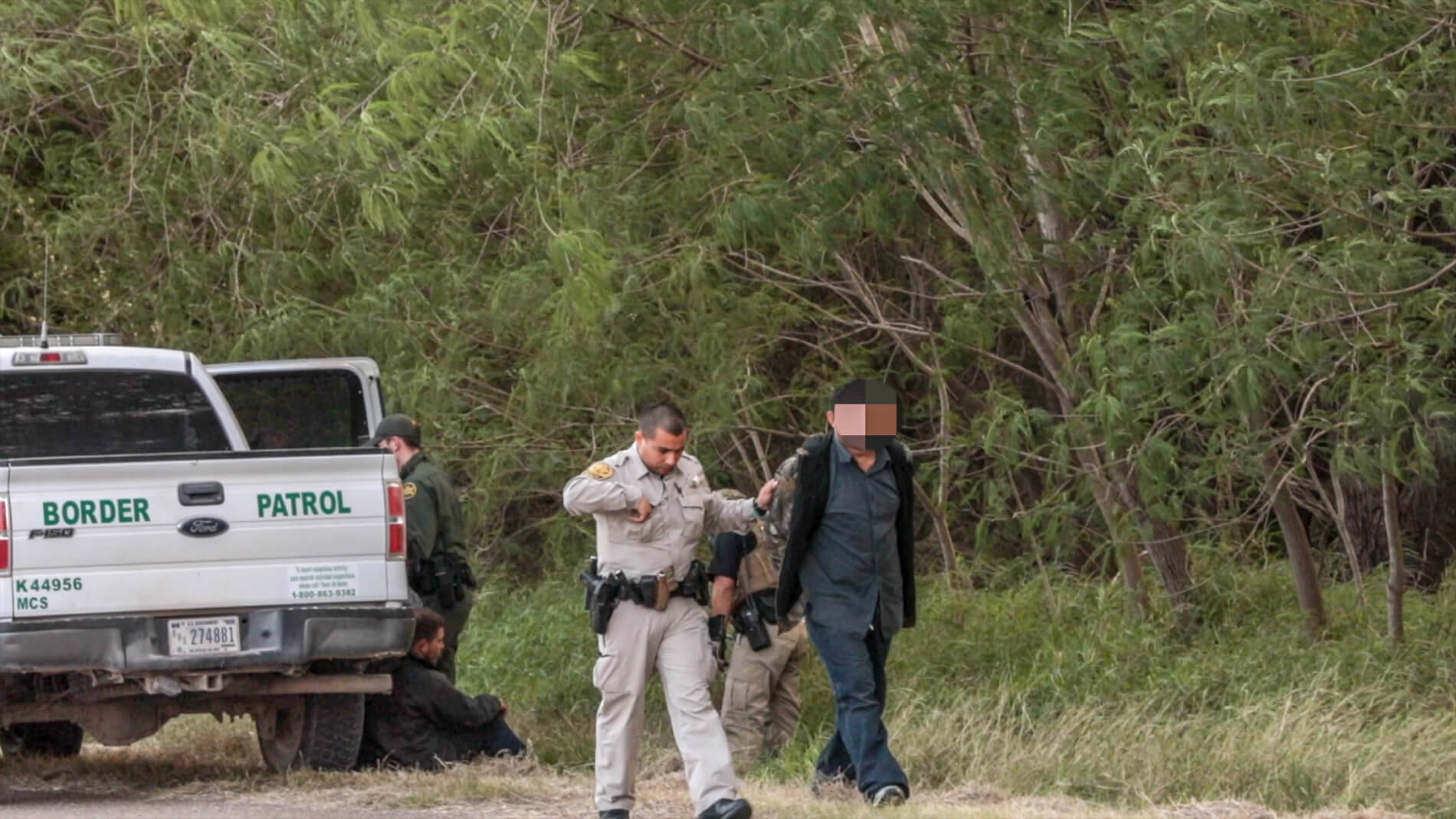
Border patrol detaining migrants outside of Mariposa Village at the National Butterfly Center. Photo: Garet Bleir
“They don’t care about their past. We do. We know where our ancestors are buried,” Mancias says. “A lot of these people left their ancestors’ across the ocean and don’t care. We didn’t.”
In late January, the family members of those buried in the cemetery and allies came together to clear out the brush and tall grass that had overgrown the cemetery over time. “If we hadn’t come in here and sat down and said, you’re not going to dig this one up, they would’ve come in and bulldozed all these bodies out and who knows where they would have put them, some mass grave,” says Mancias. “All the records of these people that had lived once here would be gone. But we were able to come in here to clean this up — and they did a fantastic job.”
On Monday, June 3rd CBP stated in an unofficial response to an AP report that the Eli Jackson Cemetery is the only cemetery within the FY19 border wall funding, but that “CBP will coordinate with the appropriate stakeholders to develop measures that avoid this cemetery while still meeting Border Patrol’s operational requirements for the border wall.” This unofficial statement comes just months before the end of FY19 in September and is currently being picked up by many mainstream media outlets as a win for the Eli Jackson Cemetery.
Echoing the ‘false victories’ at Standing Rock and other movements around the country, resistor’s to the cemetery are sceptical as to what this statement really means, and some question if CBP is trying to appease the resistors to clear out Yalui Village prior to the start of construction. Families of those laid to rest in the cemetery have still not been contacted by CBP with this information, nor does the statement address the dangers to the Jackson Ranch Chapel. “Until we get a definitive answer from the government and appropriate authorities in writing we won’t stop. We’re going to continue fighting,” says Dr. Sylvia Ramirez, a descendant of those laid to rest in the cemeteries that is helping to lead this resistance.GET RID OF ADS. SUPPORT US ON PATREON!
INTERSECTING HISTORIES, CONVERGING PRESENTS
The land in and surrounding the Eli Jackson cemetery holds many intersecting groups and histories, starting with the original caretakers to the land, the Esto’k Gna people. The area surrounding the Eli Jackson cemetery was historically known as El Capote, an area encompassing ancestral villages of the Carrizo/Comecrudo. Throughout bouts of Spanish and subsequently English colonization, as well as its existence as a major outpost along the Underground Railroad, that history intersected with those of other groups, resulting in the diverse range of peoples holding ties to the Eli Jackson cemetery.

Future Chairwoman of the Carrizo/Comecrudo Nation Christa Mancias laying down tobacco on Memorial Day in prayer for the veterans laid to rest in the Jackson Ranch Chapel Cemetery. Photo: Garet Bleir
The Esto’k Gna were a nomadic people, moving all along the Rio Grande to allow resources to naturally replenish themselves, and setting up various villages along the way. This means that Esto’k Gna burial grounds and artifacts are scattered across the area in these various ancestral villages. The Eli Jackson Cemetery area was called El Capote, with nearby villages of Las Milpas, La Granjero, and Los Indios located along the river side. When Spanish colonizers invaded the area and took surveys, they had recorded these villages lining the Rio Grande every eight to 10 miles, says Dr. Christopher Basaldú, an anthropologist and member of the Carrizo/Comecrudo Nation.
Somi Se’k, the sacred homelands of the Esto’k Gna range from Southern Texas to Northern Mexico on both sides of the Rio Grande, but certain clans within the Esto’k Gna lived in different villages and areas with that. Yalui Village, which the Carrizo/Comecrudo Nation have set up in the Eli Jackson Cemetery, is on the grounds of the ancestral villages of El Capote of the Crane, Canyon, and Bear clans. Mariposa Village, which the tribe has set up at the National Butterfly Center, is on land known as Los Ebanos, and are the homelands of the Kotoname clan of the Esto’k Gna.
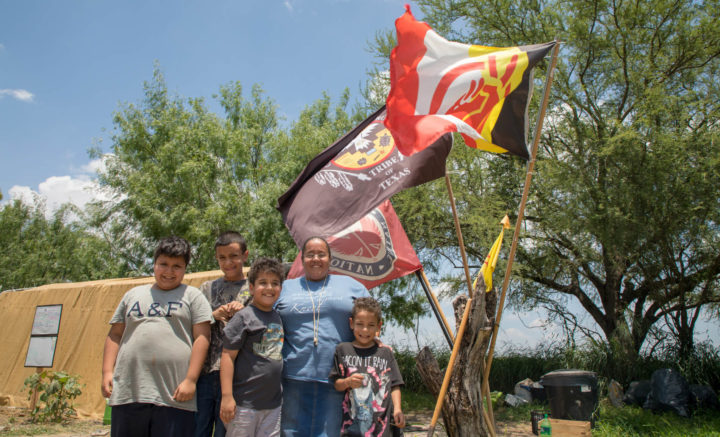
Carrizo/Comecrudo Nation Member Ruth Garcia and her four boys in Yalui Village at the Eli Jackson Cemetery. Photo: Garet Bleir
Esto’k Gna, the people’s name for themselves, translates to “human beings” or “the human people.” But Carrizo and Comecrudo are words that were used by Spanish invaders and colonizers to describe the Esto’k Gna, says Basaldú. Carrizo, in fact, is the name for an invasive reed to the area, not indigenous to the region. “The invaders gave us a name which was an invasive species, I find that interesting.” Comecrudo is far more insulting, translating directly to “eating raw food,” says Basaldú. “The intention of the Spaniards was to describe particular clans or villages of the human beings as so uncivilized that they would eat food raw.”
RESISTING THROUGH REMEMBRANCE

March against the border wall at the National Butterfly Center in conjunction with the Carrizo Comecrudo Nation. Photo: Garet Bleir; Composite: Azul Perez Lañas
The villages set up by the Esto’k Gna have not only served to help the people resist but also to remember. In the aftermath and continuation of colonization’s practice of forced forgetting, many Esto’k Gna peoples are reconnecting with their ways. Basaldú has experienced this personally.
“At the level of Texas education, the Esto’k Gna is completely erased,” says Basaldú. “When Texas and its curriculum teaches Texas history to its students, we are taught that there barely were any Native American peoples in all of the great state of Texas, which is a lie.”GET RID OF ADS. SUPPORT US ON PATREON!
“The United States, after its establishment, kept its genocidal campaign of land theft and resource theft by expanding westward, and it came into contact with ever more Native and Indigenous people,” says Basaldú. “It’s a lie that the land was empty, a self-comforting, self-serving lie that the United States of America has to tell itself in order to assuage their conscience…and justify the colonization and genocide and the settler colonialism.”

Dr. Christopher Basaldú, member of the Carrizo/Comecrudo Nation and resident at Yalui Village. Photo: Garet Bleir
Basaldú grew up wanting to learn about the people indigenous to Texas, but was told that there were no native peoples in the area at all. “I remember even as a child, feeling that emptiness, but not understanding why,” he says. After years of pursuing an education in Native American history and anthropology, Basaldú realized that he still hadn’t learned about the peoples indigenous to the lands where he was born and grew up, the Rio Grande Valley. At that time he was still under the impression that formal education had imparted upon him as a child that there were no Indigenous Peoples in South Texas.
Upon returning to the Rio Grande Valley, Basaldú eventually met Juan Mancias, who introduced himself to Basaldú as “the chairman of the Carrizo/Comecrudo Tribe of Texas, not federally recognized, but the Indigenous people of South Texas and the Rio Grande Valley on both sides of the border.” The Carrizo/Comecrudo Nation of Texas has members that have never left the area of their ancestral homelands; surviving colonization, anglicization, and five centuries of genocidal and racist policies. But even so, the tribe is not formally recognized by the United States or by the state of Texas.
“In general, the federal United States recognition simply means that the United States recognizes that a particular group of native people — a native nation — exists, and that the group of people exists as a separate people,” says Basaldú. “Well, there’s no people on Earth that needs the United States of America to validate them. Not a one, no indigenous group of people, however they are organized.”
When the two first met, Mancias asked Basaldú what his family names are and where he and his relatives were born. “Then he tells me those are my families too. We’re related. You’re Carrizo,” says Basaldú. Now one of the villagers of Yalui Village, Basaldú is strengthening his connection with his original teachings and Esto’k Gna identity, while resisting a wall that threatens the lands he grew up on and the ancestors of his people who lived upon them.
One of the Carrizo/Comecrudo’s goals of rebuilding their ancestral villages is to assist in the education of the public by reminding people “that it’s a lie from Texas history and American history that there were no aboriginal people in this area,” says Basaldú. “And the descendants of the aboriginal people in this area still exist, even if they may have forgotten… because of genocide and colonization and forced forgetting in order to protect their children from the violence of invaders.”
“Knowing that history in general sort of heals some of the scar on my heart about all that, but I haven’t learned enough to fully heal that scar yet,” he adds. “Living in a way that restores the respectful relationships between the people, not just individual natives, but Indigenous people to their homelands, to their sacred history, to their ancient ceremonies and to their languages; that’s what I mean when I talk about healing.”
FORCED FORGETTING
While this regaining of identity is actively happening today, its roots trace back to the beginning of colonization. When you walk through the Eli Jackson cemetery, reading names off of the monuments, one might not immediately recognize that many of these ancestors were also Esto’k Gna.
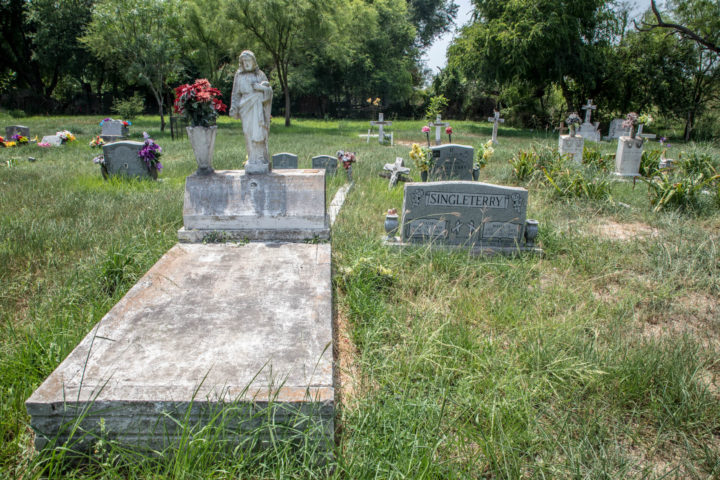
Eli Jackson Cemetery. Photo: Garet Bleir
One of the systems of colonization that Spain enacted in the so-called New World was the encomienda system, says Basaldú. The crown would grant settlers an encomienda, or a land grant, organized and authorized through the colonial government and directed by the crown. The encomendero, or landowner, was granted all of the Indigenous land within the boundaries of what then became the encomienda.
Prior to the existence of the Eli Jackson Cemetery and Jackson Ranch Chapel, the surrounding land, starting in 1767, functioned as an encomienda, under a Spanish Royal Land grant known as Porción 71, awarded to Narcisco Cavazos.
The Indigenous population already on that land became the encomendero’s forced labor, says Basaldú. At the behest of the crown and the Doctrine of Discovery, military or mercenary forces compelled indigenous communities at gunpoint or tortured the communities into obedience to work on plantations, build roads, or build houses under the authority of the encomendero.
From the Spanish perspective, the colonizers were viewing Native peoples in the region such as the Esto’k Gna as subhuman, says Basaldú. “They were just living human property that can be forced to whatever it is they needed to do.” Additionally, the encomendero was granted that land under the requirement that they convert those peoples to Catholicism, providing for the religious reeducation of Native and Indigenous peoples there, contributing to the forced forgetting of a population’s own traditions and religions.
The Indigenous peoples were obligated to build the missions that would be used to convert them. In this way, “Native people were required to build the instruments of their ideological programming,” says Basaldú. “Colonizers were forcing human beings to give up their lifeways that were given to them by Creator, give up their languages that were given to them by Creator and no longer live in such a way that they had for generations, living in constant reciprocal, respectful relationships with all other living beings around them in their homelands, through prayer, through song, through ceremony, through offerings.”
Colonization had forced many of the Esto’k Gna to completely transform their economy, their sense of place, and their ceremonies, while taking on the ceremonies of their torturers, abusers, and colonizers, he adds. “All of this was done and justified in the minds of the colonizer that native people were subhuman or inhuman or demonic. And so the economic, the political and religious forces of Europe come together in colonization in order to completely transform native people at the individual level and communal level into being second or third class Europeans on land that isn’t European.”
So in this history’s place, Texas in particular, and the U.S. as a whole has built “myths of grandiosity and bravery and manifest destiny to replace the actual stories that established the lifeways of indigenous people,” he says. “But if you erase the stories of the lifeways of Indigenous people, the land looks empty,” the Rio Grande Valley looks empty of meaning without the millennia of understandings that were once provided by the Esto’k Gna people.
“The erasure of their lifeways is the other form of genocide. You can still have a group of living individuals, but if they’re not living their lifeways…they’re no longer a people living the way Creator intended,” says Basaldú. “If they’re not living their life ways as native people, you’ve committed genocide.”
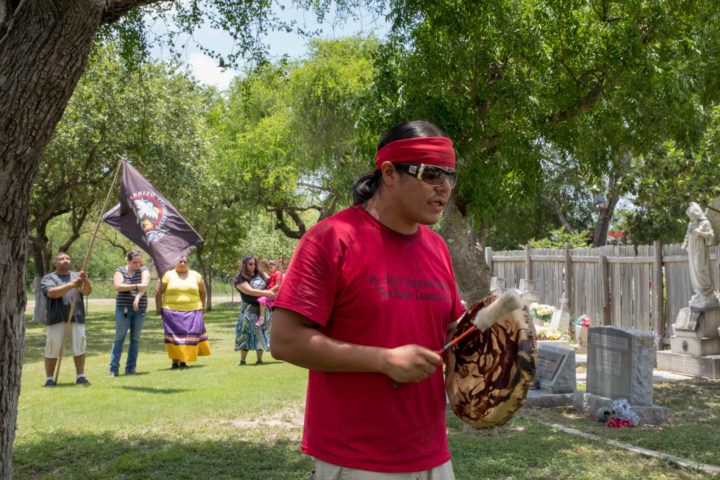
DuWayne Redwater of the Standing Rock Sioux Nation praying for the ancestors and relatives laid to rest at the Jackson Ranch Chapel Cemetery. Photo: Garet Bleir

Photo: Garet Bleir
With the encomienda system and then the subsequent Spanish land grant system, an encomendero would give his Spanish name to the people that were from that land. So the Esto’k Gna’s last names transitioned into names such as “de Garcia” or “of Garcia,” if the encomendero was named Garcia. As time went on, “de Garcia” transitioned into simply “Garcia” and the new last name takes hold while the Indigenous last name was forgotten, translating into another tool of forced forgetting. This means when you walk through the Eli Jackson Cemetery, many of the last names are not immediately recognizable as Indigenous.
The same pattern applies with anglicization of names as another wave of English colonization, invasion, and settler colonialism comes through the area, as non-English-language names were changed to spellings nearer to English sounds or completely replaced altogether with similar or equivalent English names. This process took place through marriage, wanting to change a last name to get a job more easily, or ranches at times changing people’s names because they found them difficult to pronounce. This has resulted in many people throughout Texas, such as Basaldú, not initially realizing their Indigenous ancestry and identity.
People were forced to adapt to the systems they were left with in order to survive and give life to the next generation, says Basaldú. When the settlers came into this land, they married the local population and the local people. “The local people through these different cycles of colonization were Hispanicized, but they were descendants of the Esto’k Gna,” he adds.
As an area that experienced both Spanish and English colonization afflicted upon the Indigenous population there, as well as its existence as an outpost upon the southern route to freedom on the Underground Railroad, the Jackson Ranch Chapel and Eli Jackson cemetery and surrounding land is one intertwined with a diverse range of intersecting histories.
FLEEING SOUTH, SEEKING FREEDOM
While this area is now under intense scrutiny for the “crisis” at the border with individuals fleeing oppression continuing to be misrepresented by president Trump and his supporters, around 160 years ago this land served as a major hub of the Underground Railroad through which slaves in the Deep South escaped oppression by moving in the opposite direction – south into Mexico, where slavery was outlawed at the time.

Map of the Underground Railroad including the journey south into Mexico. Source: National Geographic Society
In the decades following the initial bout of English colonization of the early 1800s in Texas, Nathaniel Jackson, the son of a wealthy plantation owner, decided to marry Matilda Hicks — a freed slave he had emancipated from his family’s plantation — and flee Alabama with her. Nathaniel also invited 11 other slaves he had freed to join the couple on their journey South.

Nathaniel Jackson.Photo: Courtesy of Margaret H. McAllen Memorial Archives
The 1857 Dred Scott decision was the tipping point for Matilda and Nathaniel. This Supreme Court decision effectively decided that the constitution does not apply to African Americans, black peoples, and slaves as they could not claim U.S. Citizenship. This decision also limited resistance to the Fugitive Slave Act and in order to adhere to the act legally obligated all citizens of the United States to capture and return fugitive slaves to their “owners.” This decision put Hicks in further danger as did the illegality of the couple’s marriage.
So in 1857, the couple set off on a two-month journey in six covered wagons along with 11 freed slaves from Nathaniel’s father’s plantation and several other families. Their plan was to head into Mexico, but most of the families knew no Spanish and were Protestant – in contrast to Mexico, which was primarily Catholic at the time. So upon arrival on the banks of the Rio Grande River, they decided not to cross it to find freedom in Mexico, but instead bought 5,355 acres on the banks of the Rio Grande for $2,000 in present-day San Juan and Hidalgo, Texas. The property spanned approximately three quarters of a mile along the river and 13 miles north into Texas. As generations went by, the settler families acculturated into the community and Spanish became the families’ dominant language.

Jackson Ranch Chapel, 1982. Photo: Courtesy of Margaret H. McAllen Memorial Archives
The Jacksons set up a homestead together with the freed slaves and other families and raised all their own food on the ranch, according to the Margaret H. McAllen Memorial Archives of the Museum of South Texas History. This included corn, pinto beans, potatoes, yams, and sugar cane in addition to cattle and sheep. By the time that the Jacksons arrived, there had already been farming and ranching families established in the area for at least a hundred years. In addition to the Mexican-Americans and Indigenous population in the area, there were descendants and heirs of the original Spanish land grantees who arrived in the 1740s and 1750s.
After settling the area, Nathaniel offered the freed slaves assistance, refuge, and shelter at the Jackson Ranch–or they could continue on into Mexico where slavery had been outlawed. Not all freed and fugitive slaves decided to cross into Mexico. Many stayed behind as this outpost on the Underground Railroad to the South shepherded others into Mexico and to their freedom. As slavery was still legal in Texas, at any point if they decided they did not want to stay, Mexico could be reached through a short ferry ride across the Rio Grande.
JACKSON RANCH CHAPEL
Both the Jackson Ranch Chapel, built by one of Nathaniel’s sons, Martin Jackson; as well as the Eli Jackson Cemetery, named after his other son were designated as State Historical Markers in 1983 and 2005 respectively by the Texas Historical Commission. When you first enter the metal gate opening up to the Jackson Ranch Chapel and the adjoining cemetery holding the descendants of Martin, you are greeted by a historical marker acknowledging that this area was the first Protestant Church, and the first Spanish-speaking Protestant Church, in all of the Rio Grande Valley. The chapel is also the oldest Protestant Church still intact in the RGV.

Martin Jackson with his son Ben Jackson. Photo: Courtesy of Sylvia Ramirez
In the winter of 1874 to 1875, as part of a program to evangelize the Spanish-speaking population of Texas, the Rev. Alexander H. Sutherland purchased the chapel from Martin Jackson for $1 and organized the congregation of Jackson Ranch Church. The program was led by the Methodist Episcopal Church South (MEC,S), a denomination which resulted from a split in the Methodist Church over the issue of slavery, which the MEC,S strongly opposed. By 1859, two years after the Jackson’s arrival in South Texas, the MEC,S had enrolled over 700,000 members nationwide including nearly 200,000 black peoples (most of whom were slaves). The MEC,S also had enrolled over 4,000 Indigenous peoples – serving as a continued erasure of the native religions of Indigenous peoples.
Services were conducted regularly through the course of Nathaniel Jackson’s life except during the Civil War. During the late 19th and early 20th centuries, the Jackson Ranch Chapel was an epicenter of both social and spiritual life for the ranch community and surrounding rural areas, and became an important place for people to congregate, worship, and enjoy each others’ company, a tradition that has been passed on through the generations.
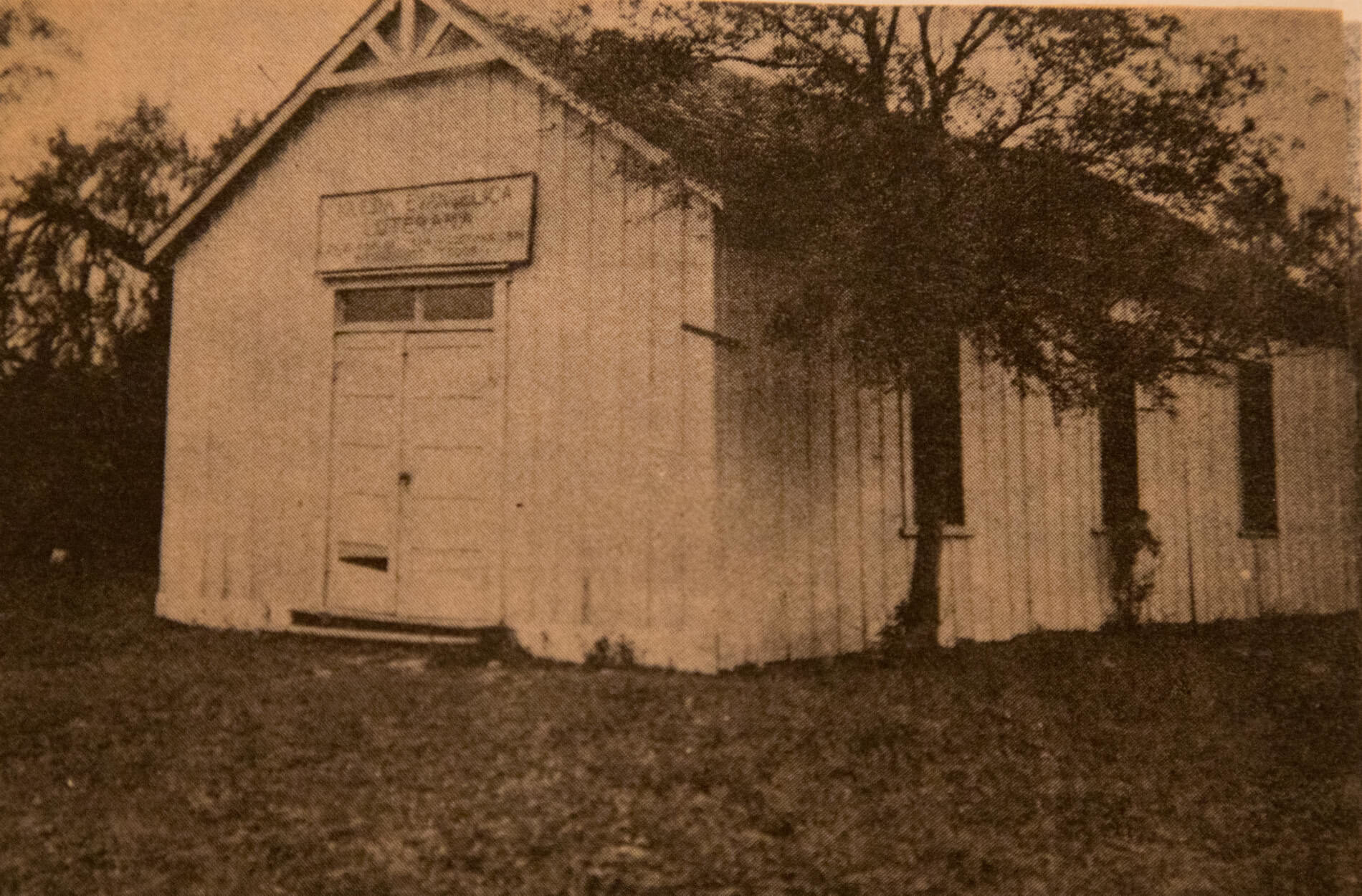
Jackson Ranch Chapel, 1940s. Photo: Courtesy of Margaret H. McAllen Memorial Archives
The Jacksons’ self-liberation and actions to escape racial oppression and slavery is a history that holds meaning for the descendants of Matilda and Nathaniel to this day. Today, 162 years after Matilda and Nathaniel’s original journey, their descendent Dr. Ramiro Ramirez is fighting along with his family and other descendants of those laid to rest in the cemetery to protect this history and their ancestors’ remains. Ramiro is the great-grandchild of Nathaniel’s son Martin Jackson, who built the Jackson Ranch Chapel and is now buried in the adjoining cemetery. He is also a descendent of Esto’k Gna ancestors and a distant relation to Mancias and Basaldú.

Ramiro Ramirez, great-great grandson of Nathaniel Jackson sitting inside the Jackson Ranch Chapel. Photo: Garet Bleir
Ramiro remembers up to 50 members at a time coming to the chapel for worship, mostly relatives. The chapel served as a place of worship for 150 years until 2008, when Hurricane Dolly ravaged most of the area, including the chapel. This halted public and family sermons at the site, but the chapel has since been restored. It is Ramiro’s dream that the church will soon be active again. The pattern of flooding had been commonplace since its initial construction, with annual or biannual flooding partially washing away the chapel. This required community members to continually rebuild the chapel – originally constructed of adobe, logs, and palm leaves; as well as the nearby houses.

Jeremy Blackbear of the Rosebud Sioux Nation after a long rainstorm sitting in front of where the sacred fire usually burns at Yalui Village. Photo: Garet Bleir
CONFLICT WITH THE CONFEDERACY
The chapel had attracted many moving to the Rio Grande Valley to join the community. Shortly after the Civil War, a Confederate veteran named Lena Helen Box came to the river to pursue work as a customs broker. Attracted to the Jackson Ranch for the Methodist services at the Jackson Ranch Chapel, he married Louise Singletary, granddaughter of Matilda Hicks.
Box wasn’t the only Confederate soldier who found his home in an outpost of the Underground Railroad. Also buried at the Jackson Ranch Chapel Cemetery is Abraham Rutledge. Rutledge was a white man who came with the Jackson caravan in 1857 and was married to Matilda Hicks’ daughter from a previous marriage, Nancy. In December of 1862, during the Civil War, Abraham Rutledge, along with several other ranch owners in the immediate region – some of which are buried in the two cemeteries – joined the Confederacy. They served in Capt. William Thomas’ company of Texas Partisan Rangers, which was active for four months, between December of 1862 and March of 1863.

Monument honoring Abraham Rutledge, a Confederate Soldier and member of the Texas Partisan Rangers. Photo: Garet Bleir
In recent years, the United Daughters of the Confederacy (UDC) commissioned a headstone in the Jackson Ranch Chapel Cemetery, celebrating Rutledge’s participation in the Confederacy. Across the South, the UDC has constructed over 700 monuments and other memorials honoring the Confederacy – far more than any other group, according to a study by the Southern Poverty Law Center (SPLC). According to the SPLC, the UDC has been accused by historians of extensively promoting a false history of the Civil War and the Confederacy.
Ramiro says that when he and his three daughters saw this monument constructed next to the final resting places of emancipated slaves and their descendants, they were upset. When his daughters saw the Confederate flag that was placed on the plot, they broke the stick and threw the flag across the fence as having a Confederate soldier honored there, or several, was hard for them to accept, Ramiro says. “They didn’t want to see the flag every time they came and as of right now, there is no flag.”

Ramiro Ramirez, great-great grandson of Nathaniel Jackson sitting beside the Jackson Ranch Chapel Cemetery. Photo: Garet Bleir
Abraham Rutledge is married to a stepdaughter of Nathaniel – who is buried at the Eli Jackson Cemetery. So Rutledge would most likely have been buried there as well, not the Jackson Ranch Chapel cemetery, because he is not a descendant of Martin Jackson, says Dr. Sylvia Ramirez, Ramiro’s sister. But at the time the monument was constructed, the Jackson Ranch Chapel Cemetery was better maintained and had more available space than the Eli Jackson Cemetery, she adds.
To see his monument constructed there and to see “CSA (Confederate States of America) and Texas Ranger,” blazened on that monument had shocked both Sylvia and Ramiro. Neither of the siblings had been asked for permission to construct the monument there, but “had we been asked, we would not have said it was okay because of those words: Confederate States of America and Texas Ranger; for what the Confederates did and what they represented against blacks and African Americans,” says Sylvia. Sylvia wishes more thought had been given to the inappropriate placement of the monument, as Rutledge’s monument honors his participation in two groups who were instrumental in the oppression of others lying just feet away in the cemetery.
“To have ‘Confederate States of America’ so proudly etched on that monument and to know that the United Daughters of the Confederacy went there to dedicate that with the knowledge that there are descendants of slaves buried just a few feet away; that should not have happened,” she says. “And the Texas Rangers for their association with abuse, lynchings and mistreatment of not only Mexican Americans but also Native Americans and anyone who who didn’t look like them and who didn’t have power.”
The true history of the Texas Rangers, imbued with violence and racial oppression, is one that has been mostly forgotten throughout Texas. Sylvia doesn’t remember anything of this element of the Texas Rangers’ history being mentioned while she was in school, nor do most people discuss it, she says. “I think for sure it’s been whitewashed and hopefully textbooks will change, but in a very conservative state such as Texas it’s going to be very slow, to the point where I certainly won’t live to see that change.”
While there were several Confederate soldiers within the community that the Jacksons had established, Nathaniel Jackson was a strong opponent of secession and openly supported the Federal cause even as a Southerner, according to the Margaret H. McAllen Memorial Archives. In addition to his work harboring fugitive slaves while using his land as an outpost along the Underground Railroad, there is speculation that he may have been a spy for the Union. During the Civil War, Union soldiers from the Calvary Camp located in present-day Hidalgo were even welcomed at times, with some marrying those living at the ranch and staying in the area permanently.
CONNECTING TO TRADITION, HONORING THE AFTERLIFE
Ramiro remembers as a young child visiting the Eli Jackson Cemetery to go and plant red roses at his great-great grandfather’s tombstone. Over time the wooden burial marker disintegrated, due in part to periodic flooding, leaving the location of Nathaniel’s gravesite unknown. Even though there are only 65 monuments in the cemetery, it is estimated that there are approximately 150 people lying in the grounds. Now that the border wall is coming through, the future of these remains lies in question.
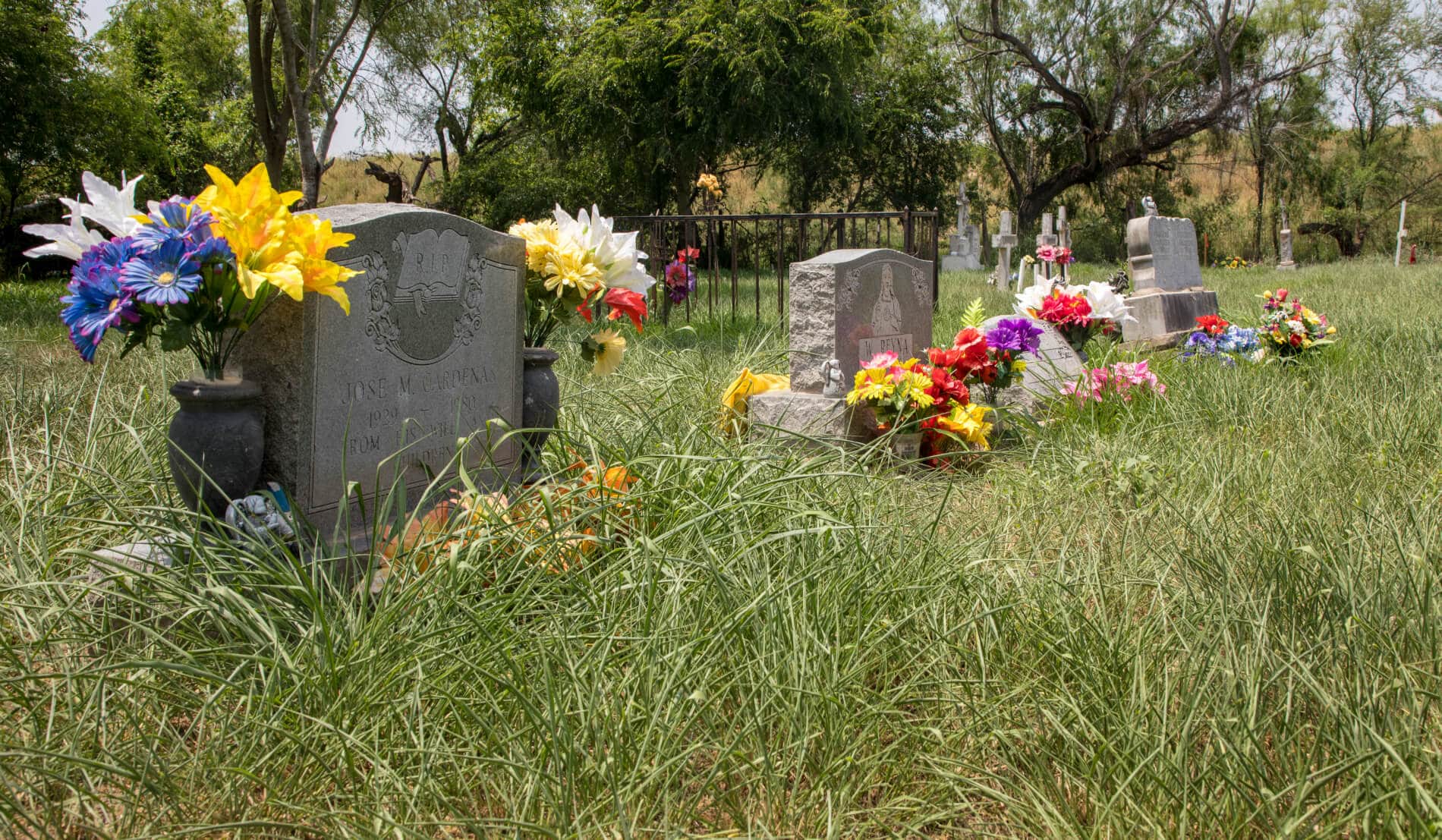
Eli Jackson Cemetery. Photo: Garet Bleir
“My ancestors come from a real heavy religious, spiritual upbringing and they planned that we would carry that on,” says Ramiro. “Tradition was what was taught to us here. A person without tradition, it’s like an animal without instincts. He’s not going to survive very well. He’ll still be alive, but he has no purpose. By us being here, we found a purpose in our lives. What brings meaning to that purpose is to share it with others. And that’s what we’re doing,” he adds.
“The Eli Jackson cemetery is going to be bulldozed, and we’re fighting that,” says Ramiro. Recently Ramiro had found that stakes had been placed in front of the chapel and families living nearby were told that the wall was going to go through where the chapel was, removing it completely.
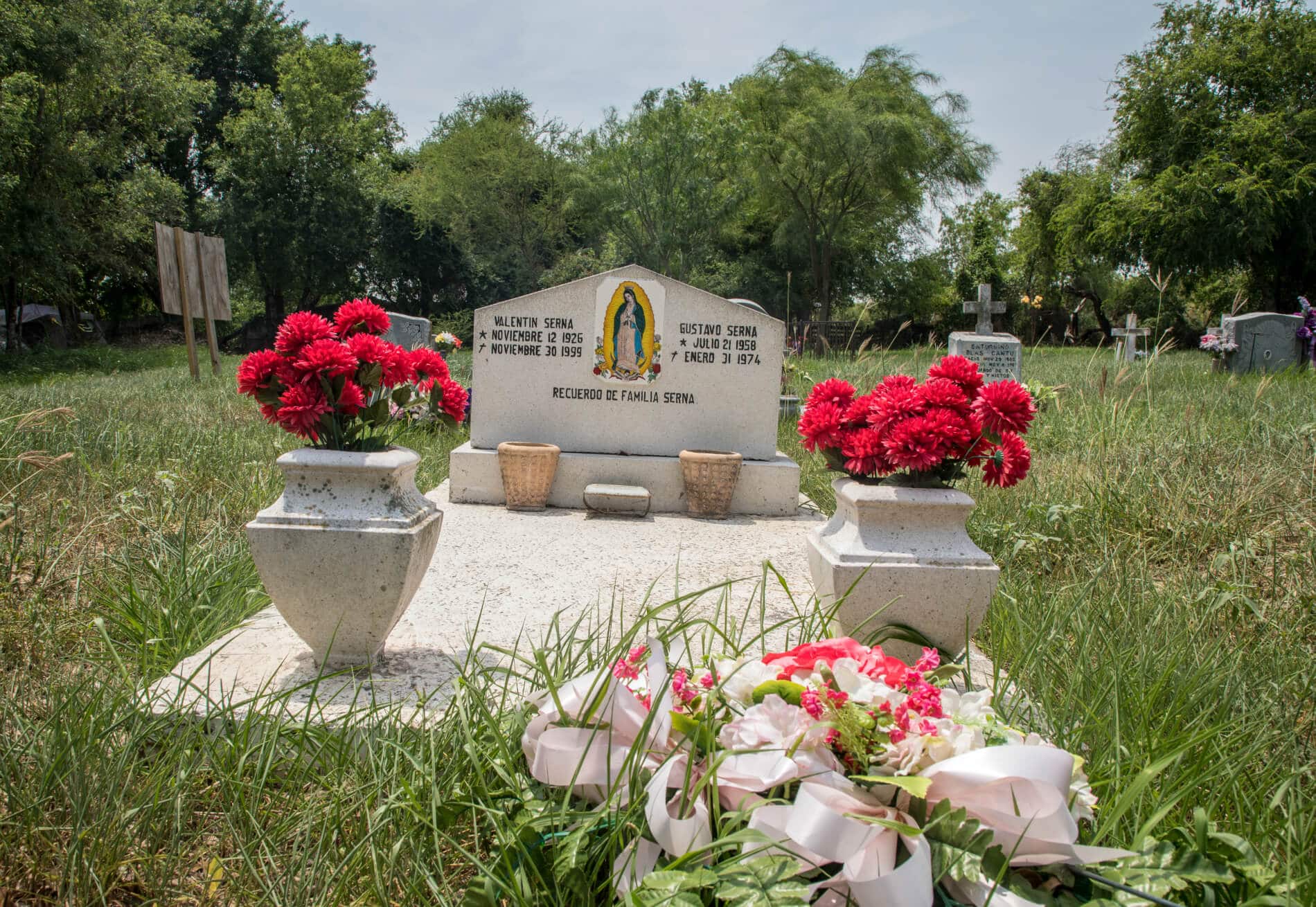
Eli Jackson Cemetery. Photo: Garet Bleir
When the border wall was announced to come through this area, Ramiro and his family were put on notice that the cemetery would be destroyed and that the chapel would also be destroyed or isolated from the rest of the United States on the southern side of the wall. “We met with Border Patrol and their response was that it’s going to happen and you can’t do anything about it,” says Ramiro. CBP told Ramiro and his family they’d try to work and be sensitive to their concerns, but that they couldn’t make any promises. “I felt it was a meeting to placate us,” he says.

Border patrol searching fields outside of Yalui Village at the Eli Jackson Cemetery in San Juan, Texas. Photo: Garet Bleir
For nearly a year, Ramiro and his family members have lived with the uncertainty of what might happen to the chapel and cemeteries, the land they’ve lived on for generations, and their cultural and spiritual connection to their ancestors and history. “Enough is Enough. These are human beings, and just because they have passed doesn’t mean they can’t be treated in a humane way,” he adds.

Ramiro Ramirez, great-great grandson of Nathaniel Jackson at the Jackson Ranch Chapel. Photo: Garet Bleir
Ramiro and his siblings already have plots in the graveyard for themselves. “I have all my relatives here and I plan to be here also. It was always said that we were going to be buried here,” says Ramiro as we speak inside the Jackson Ranch Chapel, a few yards away from his and his wife’s tombstone, engraved granite sitting beside those of his siblings’ resting places. “Can you imagine that from growing up to now when I’m 70 years old, always knowing exactly what was going to happen and to find out that now things have changed?”
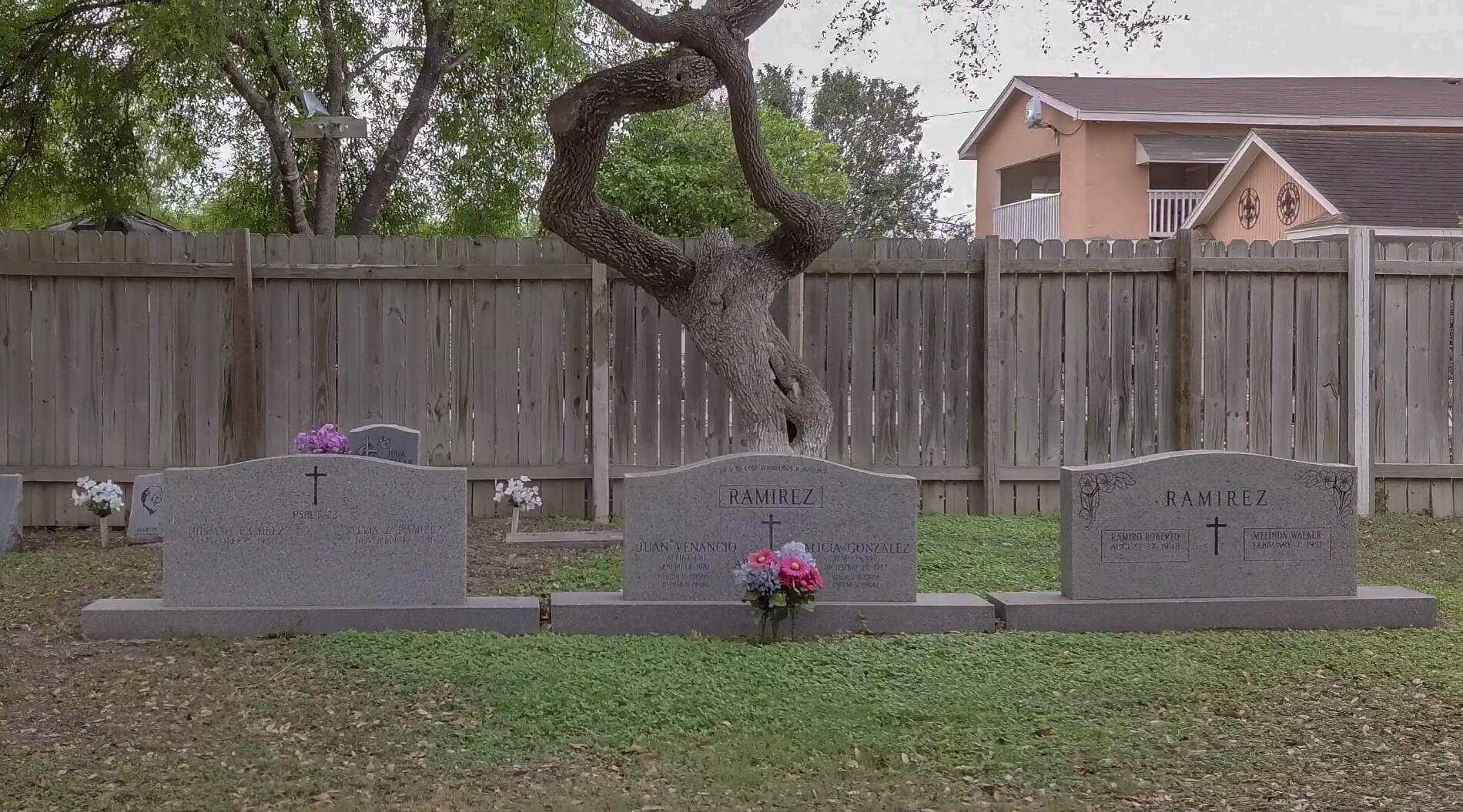
The final resting places of Ramiro, Sylvia and siblings in the Jackson Ranch Chapel Cemetery. Photo: Garet Bleir
Ramiro remembers a time when he was a young boy, crying in his home. His father came up to him and asked, “Por qué estás llorando, why are you crying?”
“Voy a morir, I’m going to die, and I want to know where I’m going to be buried,” responded Ramiro. His father told this to his mother, who told young Ramiro: “Everybody knows where everybody’s going to be buried. It’s going to be in El Capote. It’s going to be at the cemetery that everyone else is in.”
“There was no question for all of my relatives that this is the site where we would be for eternity,” he says. “This is where I was going to be — and this is where I am going to be.”
But in the midst of this fight against the government’s destruction of her family history, Sylvia has found hope in it. Recently, when Sylvia put a call out to descendents of the Jackson family via facebook to show up for a news station that was reporting on this proposed destruction, Sylvia didn’t expect to get many people to show up on such short notice. “But about 15 people showed up that I had never met before, and all were Eli Jackson descendants,” says Sylvia. “It gave me a sense of lightness and spirituality in that small gathering. There were all these people I would never have known if this had not come to pass in this fight we have against the government.”
For Ramiro, the history of his family “makes us connect to the values that were taught a hundred years ago. We still have those same values because it was passed on generation to generation,” he says. “I can’t speak for the people in the United States, but when you ask them what is their culture, they stumble — they’re not exactly sure, or they say that we are not connected with a past.”
FIGHTING ERASURE BY UNDERSTANDING THE PAST
Forced forgetting, symptoms and tools of racial oppression and white supremacy, has affected not only Indigenous peoples in the region, but also Mexican-American and Latinx families. Ramiro remembers as a kid hiding the foods he ate, which were perceived as the “wrong foods,” and not wanting other kids to notice how their parents dressed differently.
“Our music was different, our food was different, all the components of culture were different. It wasn’t taught in the school, the libraries, or the books, but we felt if that was important enough it would be taught in school,” Ramiro says. “When I was in school being Mexican-American, Hispanic, whatever group you want to call us…we learned very little about ourselves, and that’s one of the reasons a lot of us were in a state of rejection and ended up with an identity crisis. A lot of us grew up believing we came from nothing and that we are nothing,” says Ramiro. okay to hold onto your family’s traditions and past, he adds, because when you understand the past, then you’ll understand not only now, but you’ll understand the future.”
The pasts of Sylvia and Ramiro’s ancestors are ones that have been forgotten by many in the area, and like the history of the Esto’k Gna people, they are stories that have not been honored. Within the past year the history of the Underground Railroad has been brought to the attention of researchers and media, but this history had always been there. “Just because it hasn’t been written, just because it hasn’t been documented, doesn’t mean there’s no history,” says Ramiro. “I get a kick out of people who say, New York has a lot of history, Chicago has a lot of history, but then what about the small places? They have no history? Just because we haven’t been documented, people think they don’t have to deal with it.”

Martin Jackson & Espiridiona Jackson. Photo: Courtesy of Sylvia Ramirez
Sylvia and Ramiro’s great-grandmother, Espiridiona Carillo, Martin Jackson’s wife was an Indigenous woman from Reynosa, Mexico, and was most likely Esto’k Gna. This recent realization also came from the families unification with the Carrizo/Comecrudo Nation in their fight against the border wall. “We go about our lives so busy with the mundane things that we do everyday, we often don’t get to give a lot of thought to where we came from. So having the opportunity for this information to be brought to life has been invaluable,” says Sylvia. “It enhances the relationship that I have with my ancestors and to respect them in valuing what they went through regardless of where they came from, both Indigenous peoples and people who had been former slaves.”

1943, family and non-family at the original Methodist Mission building of the Jackson Ranch Chapel. On the far right with the baby is Sylvia and Ramiro’s father Juan next to his mother Nancy Jackson, next to Nancy’s mother Espiridiona Jackson. Photo: Courtesy of Sylvia Ramirez.
“I strongly believe that this country means well and I’m sure I like to believe that once they know the history, the long history, the church, the cemeteries, the people that came down the Underground Railroad, that they’re going to rise up and stop this,” says Ramiro. “Hopefully. But right now they don’t know.”
Follow Garet Bleir Journalism on Facebook or @GaretBleir on Instagramand Twitter for videos, podcasts, and long-form article updates to come regarding these issues and published with Intercontinental Cry.
This story was made possible with a grant from the Swiss human rights organization Incomindios and first appeared at Intercontinental Cry. It is part one of an ongoing series.
MORE FROM THIS SERIES
border wall Carrizo/Comecrudo Esto'k Gna Juan Mancias Underground Railroad